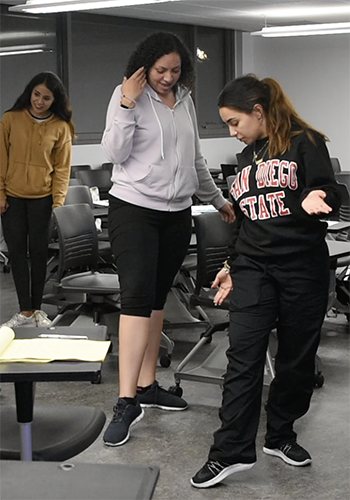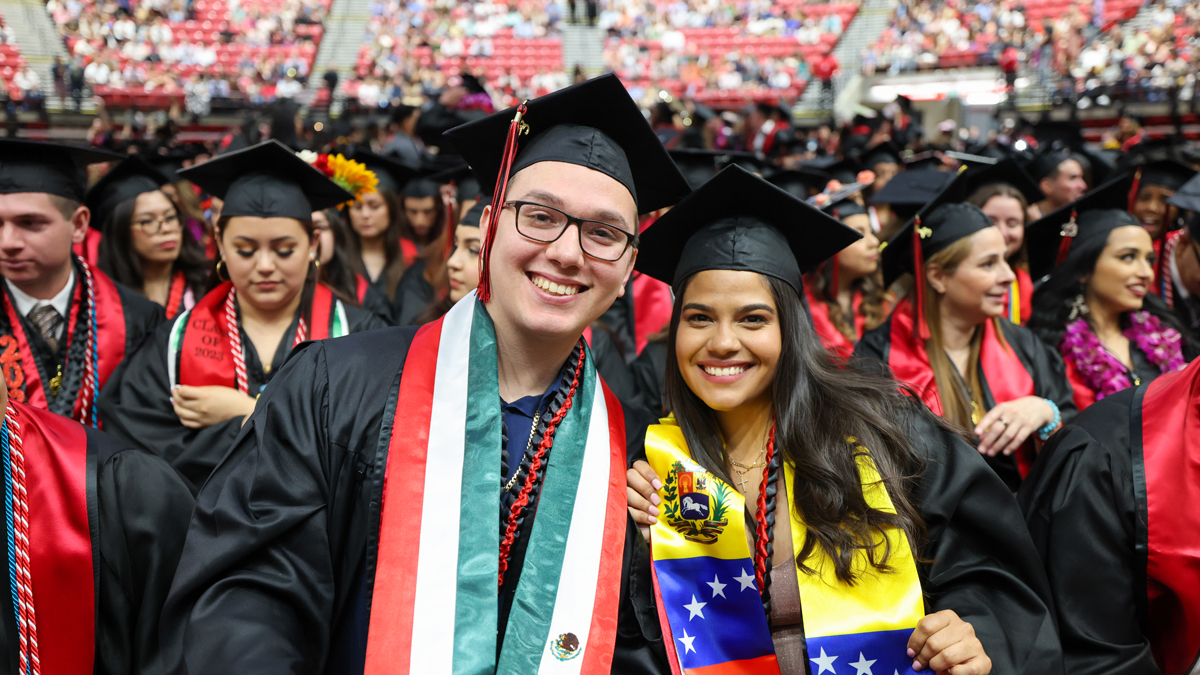Arts Alive SDSU's Teaching Initiative Announces Largest Cohort in Program’s History

One of the pillars of the Arts Alive SDSU initiative is the Interdisciplinary Collaborative Teaching Program. In this program, two faculty members from different academic areas work together to redesign pre-existing courses to create an educational experience that enriches learning outcomes for both classes.
For the first time in the program’s history, five course collaborations have been selected to participate.
About the ICT Program
Participating faculty must modify their courses with interdisciplinary goals in mind, and students who enroll in these courses must engage across disciplines in order to explore a topic from multiple perspectives and through various learning modalities. One of the goals of the program is for both students and faculty members to consider familiar ideas in new ways.
Paired courses are offered at the same time, on the same day, and are each assigned their own location, allowing faculty to determine when to bring their students together for combined sessions.
“It was very empowering,” said Senior Music Major Natéa Cooke, who participated in an ICT collaboration in Fall 2019. “As a student, I felt more seen, heard, and more comfortable speaking my mind. I was able to collaborate with students I otherwise would have never met and find more well-informed and compassionate ways to look at the world.”
Established in 2015, the ICT Program has expanded opportunities for students in eleven separate collaborations. Arts Alive SDSU released a call for proposals for new collaborations in September 2020, and received a record-tying number of submissions.
Awardees will participate in a semester-long workshop this spring focusing on course development and strengthening the collaboration as each course must be taught for a minimum of two semesters.
“The new cohort of participants always brings fresh energy and insight to the workshop sessions, which ultimately benefits the students,” said Eric Smigel, Chair of Arts Alive SDSU. “The program content is unique each time since the fused courses are created by our imaginative faculty, who are exploring constantly changing issues in their fields of study.”
On November 18, the Office of Faculty Advancement released the announcement of which course collaborations had been selected to participate in the ICT Program. With five collaborations, this marks Arts Alive’s largest cohort in the program’s five-year history. The selected course collaborations include:
New Course Collaborations
- Kim Stringfellow, M.F.A. (School of Art + Design)
- Allen Gontz, Ph.D. (Department of Geology)
- ART 440: Digital Photography II
- SCI 596: Global Impacts of Climate Change
Integrating processes of observation and analysis, this collaboration will explore key concepts of landscape and still-life photography, and will integrate with the study of ecology and landscape variations.
- Kline Swonger, M.F.A. (School of Art + Design)
- Lluvia Flores-Renteria, Ph.D. (Department of Biology)
- ART 249: Environmental Presentation
- BIOL 530: Plant Systematics
This course collaboration will expose students to the diversity of forms and functions in plants as well as environmental design processes and techniques, focusing on the biological, environmental, and social benefits of diversity.
- Katie Turner, Ph.D. (School of Theatre, Television, and Film)
- Richard Bradway, M.S.W. (School of Social Work)
- THEA 431: Workshop in Improvisational Acting
- SWORK 381: Practice Skills Micro
Students will practice exercises and strategies for navigating emotionally challenging interpersonal interactions in both acting and counseling-related environments, paying special attention to the study of written, verbal, and non-verbal communication.
- Chris Warren, Ph.D. (School of Music & Dance and School of Theatre, Television, and Film)
- Aaron Elkins, Ph.D. (Department of Management Information Systems)
- MUSIC 560: Music and Visual Media
- MIS 620: Electronic Business and Big Data Infrastructures
By investigating techniques for visualization and sonification of large data sets, students in this collaboration will explore methods and technologies for connecting disparate digital media practices.
- Mary Cale Wilson, M.F.A. (School of Art and Design)
- Carlos Figueroa Beltran, Ph.D. (Center for Latin American Studies)
- ART 526/627: Clay and Glaze Technology in Ceramic Design
- LATAM 580: Indigenous Communities of Mesoamerica
Exploring the cross-section of art, archaeology, and ethnohistory through the study of Mesoamerican art, this collaboration allows students to examine the context, historical practices, and function of the visual arts in the Mesoamerican world.
Looking Forward to Academic Discovery
Professor and Chair of the Department of Geological Sciences Allen Gontz will be participating in the newly announced cohort of the ICT program.
“Ideally, we’ll have artists teaching scientists art methods and practices, while the scientists teach the artists about the aspects of the impacts of climate change through peer learning and coached activities and events,” said Gontz.
The new course collaborations will be taught starting in the Fall 2021 semester.
“We hope that faculty and students experience a renewed sense of wonder at academic discovery, and recognize that creativity, empathy, and knowledge are interconnected,” said Smigel.

